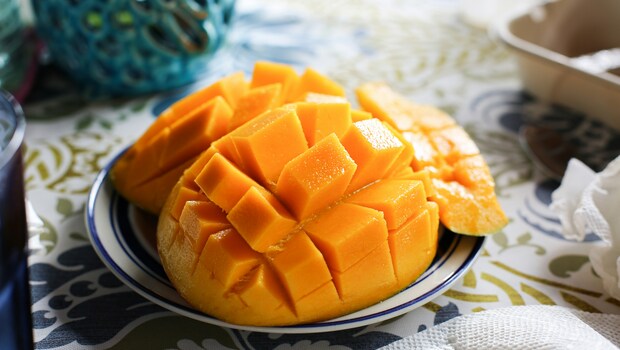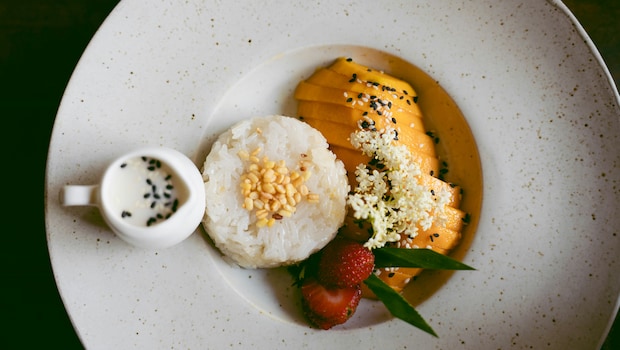Mango season is at its peak, and if you are walking through your local market or scrolling through food reels, this juicy golden fruit can be spotted everywhere. This is literally the time to indulge in aamras, mango lassi, mango kulfi, and every other dish that lets this fruit shine! But recently, one dessert in particular has caught the attention and taste buds of foodies, and it is Thai mango sticky rice! With its creamy coconut-infused rice, soft mango slices, and light sweetness, this dessert is like a tropical dish in a bowl. And if you are making it at home for the first time, there's something that can make or break your dish, and it's the temperature you serve it at. But what is the suggested temperature, and why is it important? Let's find out the main reason behind it.
Also Read: 5 Unexpected Hacks To Make Your Mangoes Last Longer
So, What Temperature Should Mango Sticky Rice Be Served At?

Nowhere in the dessert sphere will you find another dish like mango sticky rice. It is sweet, rich, and vibrant, blending creamy coconut rice with juicy mango. Mostly, this Thai dessert can be found in any trendy restaurant or cafe, but how it actually tastes depends on the temperature it is served. The ideal temperature to serve mango sticky rice is warm sticky rice and cool mango. Freshly steamed rice stays soft and chewy, and absorbs the coconut milk better when it's slightly warm. Make sure to serve the coconut sauce warm or at least lukewarm to coat the rice properly. Even while visiting Thailand, you will find Mango Sticky Rice being served a little warm or at least at room temperature. In fact, you donot need to travel to Thailand to enjoy Mango Sticky Rice anymore. Today, several Asian restaurants across India feature this iconic dessert on their menus. Just open your favourite food delivery app, place an order, and savour the unique taste and texture from the comfort of your home.
If you use ingredients at boiling hot temperatures, it will only make the glutinous grains dismember and turn into a mushy paste. So, it is important to strike a balance between the warmth of ingredients if you are serving homemade mango sticky rice to your guests.
5 Quick Tips To Make Perfect Mango Sticky Rice
1. Use Ripe Mangoes

Photo: Unsplash
While choosing mangoes for your dessert, look for ones that are naturally sweet, juicy and don't contain much fibre. For this, mango varieties like Alphonso or Kesar would work well. Make sure to note that they are ripe enough to slice neatly but not overly sweet. Chilled mango works perfectly for mango sticky rice.
Also Read: How To Freeze Mango Cubes: The Easiest Way To Make Mango Season Last For Months
2. Soak Sticky Rice Before Steaming
Make sure to soak sticky rice for 4-6 hours before cooking. This would soften the grains and ensure even steaming. Don't skip this step, as soaking gives the rice that signature chewy texture that ensures that the coconut sauce stays in place.
3. Don't Boil The Rice
Boiling sticky rice will make it unevenly cooked. Steaming keeps the grains separate yet sticky. You can use a muslin cloth for better results. This method also helps the rice soak up the coconut milk evenly.
4. Gently Heat The Coconut Milk
As mentioned above, never bring the coconut milk to a boil. High heat will make it curdle. Instead, warm it gently on low heat with sugar and a pinch of salt. This gives you a smooth, silky sauce that mixes beautifully with the rice.
5. Reheat Smartly
If you are making the dish in advance, store the coconut sauce and sticky rice separately in the fridge. When ready to serve, sprinkle some water over the rice and microwave gently. Warm the sauce on low heat. Reheat just enough to bring back the soft, comforting texture without turning it into mush. Or, if you are craving it fresh, simply order Mango Sticky Rice through your favourite food delivery app and enjoy its delightful taste and texture without stepping out.
Disclosure: This article may contain links to third-party websites or resources. However, this does not affect the integrity of the content, and all recommendations and views are based on our independent research and judgment.
About Nikita NikhilMeet Nikita, a passionate soul with an insatiable love for two things in life: Bollywood and food! When she's not indulging in binge-watching sessions, Nikita can be found behind the lens capturing moments or expressing her creativity through painting.










